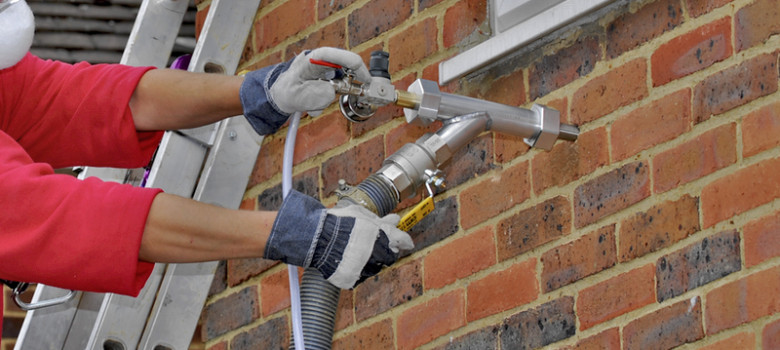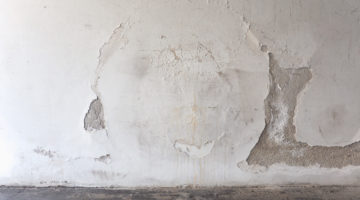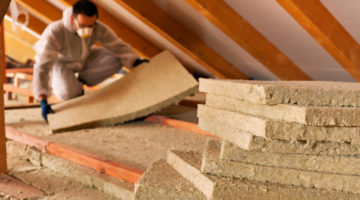
What materials can you use for cavity wall insulation?
There are two major types of cavity wall insulation: expanded polystyrene and wool. Properties typically used to be insulated with urea formaldehyde foam, but this is no longer used.
Expanded polystyrene (EPS) insulation
What is expanded polystyrene (EPS)?
Commonly known as EPS, expandable polystyrene is a rigid, lightweight, foamed plastic product with excellent thermal insulation and impact resistant properties. EPS is produced when pentane, dissolved in small polystyrene beads, is made to expand under the influence of heat and steam. These foamed beads can be moulded into a wide range of shapes and sizes suitable for a wealth of applications.
What are the user benefits of EPS?
- Excellent Thermal Insulation: EPS is 98% air and is therefore an excellent thermal insulation material.
- Proven Acoustic Insulation: EPS absorbs sound, both impact sound in floating floors and airborne sound for walls.
- Resistant to Moisture: EPS resists degradation by absorption of water.
- Resistance to Humidity: EPS has excellent mechanical and thermal properties which are unaffected by humidity because EPS does not absorb water or water vapour.
- Lifetime Durability: EPS does not decompose and as a result provides lifetime application.
- Cost Effective: EPS offers the best price/performance ratio compared to any other insulation material.
- Easy to Install: EPS is light, practical, safe and comfortable to handle and install.
- Flame Retardant: There are two grades: FR grade, a version that is self-extinguishing that includes a flame retardant and non-FR without a flame retardant.
- Easy to Transport: EPS is almost as light as air, so it saves fuel in transport.
Does EPS Foam insulation and packaging materials contain chlorofluorocarbons (CFCs) or HCFCs?
No. EPS foam products have never been manufactured with CFCs. The expansion agent for EPS material is pentane.
What are CFCS? What is their impact on the ozone?
Fully halogenated chlorofluorocarbons (CFCs) are a family of chemical compounds used mainly as refrigerants for freezers, refrigerators and air-conditioning units and as industrial cleansing solvents primarily in the high-tech industry. CFCs are also used as an expansion agent in the manufacture of isocyanurate thermal insulation, some extruded polystyrene foam used for thermal insulation, and food service containers.
Are EPS products recyclable?
EPS is 100 per cent recyclable and in the UK is currently being recycled at higher levels than either glass or aluminium.
Used polystyrene has no impact on the environment even in landfill sites or in incinerators, nor does it contain substances that could pollute the air or soil. Crucially, the manufacture of EPS solutions does not release hydrosoluable substances that could contaminate ground water supplies either.
Is EPS biodegradable?
Although EPS foam does not biodegrade, it is benign to the environment and provides a stable fill material similar to earth, rock or concrete
How does EPS behave in the event of a fire?
Like practically all organic building materials polystyrene foam is combustible. However in practice its burning behaviour depends on the conditions under which it is used, as well as the inherent properties of the material.
These inherent properties differ depending on whether the cellular material is made from EPS with or without a fire retardant additive. The bonding of other materials to cellular polystyrene also considerably affects its burning behaviour.
When installed correctly, expanded polystyrene products do not present an increased fire hazard. It is strongly recommended that expanded polystyrene should always be protected by a facing material.
Wool insulation
Another option is wool insulation. Types include rock wool and mineral wool. Coarse fibres are blown into the cavity under pressure, and expand out to fill the space.
The advantage is that this form of insulation is fairly cheap and easy to install. It is the most common type and is often installed under the free insulation schemes as a result.
The downside is that it can only be used for standard and wide cavities, as it can become patchy in cavities of less than 50mm or so. Poorly or incorrectly installed wool insulation is often the reason behind many of the problems associated with this form of insulation.
Installing Cavity Wall Insulation
Need cavity wall insulation? We have scoured the country for the best tradespeople, so that we can make sure we only recommend those we really trust.
If you would like us to find you a local insulation installer, just fill in the form below and we will be in touch shortly!











Good Information,pl.confirm us the proper sources for Cavity Wall insulation in Aurangabad-Maharastra,India.
had to remove a brick from outer wall because of damp problem..found piece of brick bridging the cavity..removed this but polystyrene beads fell out..before replacing removed brick can I replace beads in cavity ?
Hi P hopwood, that is unfortunately a common issue – the cavity is often used as a bit of dumpling ground when the builders are laying the wall. In terms of the beads falling out, that actually means that the cavity wall insulation was installed incorrectly. When beads are injected into the cavity, they are supposed to be injected with a glue that binds all the beads together. The fact is, many cavity wall installers look for shortcuts, and by just injecting in the beads without the glue, they save a lot of time – more jobs can be done, they make more money. The issue is that problems only come to light when things like this happen (a brick is removed). The first thing to do is try to get in touch with the company that installed the beads and ask to see the details of the products they allegedly used – if it does mention glue (as it should) then they have not done the job properly and they should come and fix the works.
In terms of topping up the existing insulation, it shouldn’t be a problem but it might be a good idea to remove what is there first and get it done properly.